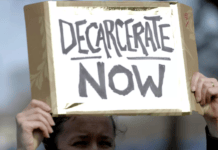Much of the momentum in the movement to reform the use of solitary confinement in the United States comes from the work of prisoners themselves
by Nur Lalji
On March 18, author and activist Sarah Shourd spoke to Democracy Now! about the time she spent in an Iranian prison after crossing the border from Iraq while on a hike with two friends. Shourd was held for more than one year and spent much of that time in solitary confinement. Here’s how she described the experience:
“I spent hours and hours crouched by the small food slot in my door, just listening for sounds, pacing compulsively, eating my food with my hands. And there were times that I screamed and beat at the walls of my cell.”
 Shourd went on to point out that solitary confinement – which involves keeping an inmate alone in a small cell from 22 to 24 hours a day – doesn’t just happen in faraway places like Iran. Roughly 80,000 people are held in solitary in the United States on any given day, according to the Bureau of Justice Statistics, in many cases for minor violations of prison rules (or no violation at all – ed.).
Shourd went on to point out that solitary confinement – which involves keeping an inmate alone in a small cell from 22 to 24 hours a day – doesn’t just happen in faraway places like Iran. Roughly 80,000 people are held in solitary in the United States on any given day, according to the Bureau of Justice Statistics, in many cases for minor violations of prison rules (or no violation at all – ed.).
Juan E. Méndez, U.N. special rapporteur on torture, has pressed the U.S. government to end its use of long-term solitary confinement. “Even if solitary confinement is applied for short periods of time,” he said in a news release, “it often causes mental and physical suffering or humiliation, amounting to cruel, inhuman or degrading treatment or punishment.”
Meanwhile, psychologists have expressed concern over the link between solitary confinement and mental illness. Craig Haney, professor of psychology at University of California, Santa Cruz, interviewed hundreds of prison inmates as part of a research project with the National Academy of Sciences. At a hearing before a subcommittee of the U.S. Senate in 2012, Haney described the hallucinations and panic attacks experienced by many inmates held in solitary confinement.
“For some prisoners,” he said, “solitary confinement precipitates a descent into madness.”
Juan E. Méndez, U.N. special rapporteur on torture, has pressed the U.S. government to end its use of long-term solitary confinement. “Even if solitary confinement is applied for short periods of time,” he said in a news release, “it often causes mental and physical suffering or humiliation, amounting to cruel, inhuman or degrading treatment or punishment.”
Activists have been advocating this position for decades, and we’re seeing a renewed attention to the issue. Vikki Law, author of “Resistance Behind Bars: The Struggles of Incarcerated Women,” credits the prisoners themselves: “It(‘s) the actions of the people in prison that pushed these issues into the spotlight and into media headlines,” she told YES!
Here are a few recent signs of progress.
1. Hunger strikers at Pelican Bay put solitary on the map.
Last summer, more than 30,000 prison inmates at Pelican Bay State Prison and other California facilities went on hunger strike, some for 60 days, to protest the conditions in which they were held. Representatives of the strikers issued five core demands, including significant reforms to the prison’s policies regarding solitary confinement.
Pelican Bay is known for its widespread use of solitary. As Méndez wrote in his report, over 400 inmates there have spent more than a decade in isolation.
In February, California lawmakers held a hearing to assess the situation at Pelican Bay. Inmates were not allowed to speak at the hearing but published their banned testimony, in which they called for a prison system that achieves “segregation from the general population, but not torture or dehumanization.”
Although the inmates haven’t yet gotten the policy changes they wanted, California State Sen. Loni Hancock introduced new legislation on March 17, which aims to increase independent oversight in the use of solitary confinement.
2. A plan to hold the designers of solitary confinement cells accountable.
Founded in 1981, the group Architects/Designers/Planners for Social Responsibility (ADPSR) is committed to the creation and maintenance of peaceful, environmentally friendly spaces that encourage the development of social justice. The group became interested in prison design in 2004. After Méndez released his report, they decided to take on the issue of solitary confinement – in a way that only architecture-world insiders could do.
The group began a petition demanding that the American Institute of Architects include “enforceable language” in its code of ethics and “prohibit the design of spaces for killing, torture, and cruel, inhuman or degrading treatment.”
The institute’s code of ethics already forbids architects from building spaces that facilitate human rights violations, explained Raphael Sperry, president of ADPSR. But the code contains no enforceable language and is therefore essentially powerless.
Sperry hopes that, by changing this, the AIA can end the design of solitary confinement cells. Sperry says the group has been presenting their petition to local chapters of the AIA and will submit the petition at the national level after receiving support from several states. So far, the San Francisco and Portland, Ore., chapters of the AIA have endorsed the petition.
3. New York state agrees to reform its use of solitary confinement.
In February, the New York State Department of Community Corrections became the largest prison system in the country to commit to reforming its use of solitary confinement.
The decision followed a class-action lawsuit by the New York Civil Liberties Union against the state’s use of this practice. According to the NYCLU’s report, New York prisons had placed minors and pregnant women in solitary confinement. Some inmates were held in solitary for years, and sometimes decades, at a time.
4. Leadership from the top.
Last December, the executive director of the Colorado Department of Corrections, Rick Raemisch, spent a night in solitary confinement – and wrote about his experience in The New York Times. According to Raemisch, being in solitary for 20 hours – “practically a blink” compared to what most prisoners would face – was unbearable. He describes leaving the experiment determined to drastically reduce the use of solitary confinement in Colorado.
“Knowing that 97 percent of inmates are ultimately returned to their communities, doing anything less would be both counterproductive and inhumane,” he wrote.
5. Orange is the New Black author Piper Kerman brings issue of solitary to Netflix viewers.
In February, the Senate Judiciary Committee’s Subcommittee on the Constitution, Human Rights, and Civil Rights heard testimony from groups and individuals who spoke about the negative impacts of solitary confinement.
Among those who testified was Piper Kerman, author of the hit Netflix show, Orange is the New Black. Kerman, who herself spent a year in prison (though never in solitary), focused on the issue of women in solitary confinement.
Kerman’s writing and activism could help a lot of people better understand what it’s really like in solitary confinement. Jesse Lava, who runs Beyond Bars, a project of Brave New Films that works on issues of mass incarceration, wrote in Truthout about the potential significance of Orange’s realistic depiction of prison:
“A minute-long montage of one prisoner’s crushing terror, boredom and detachment from reality while in (solitary confinement) may have done more to illustrate the horror of solitary confinement for Americans than all of this past month’s news articles about the hunger strike (at Pelican Bay State Prison).”
Although not everyone may agree, the show is certainly bringing awareness of the issue to a wider audience.
6. Legal action to protect youth with disabilities.
On behalf of three youth offenders, disability rights advocates joined up with two law firms to file a federal class-action lawsuit against California’s Contra Costa County Juvenile Hall. The lawsuit alleges that the county’s juvenile facility routinely places young people with disabilities in solitary confinement for up to 23 hours in a day – sometimes triggering psychotic breaks – and fails to provide special education for them as required by federal law.
As Colorlines reports, the U.S. Department of Justice and the U.S. Department of Education took an unusual step and issued a joint statement in support of the lawsuit, insisting that the county had “a legal obligation to avoid placing students with disabilities in restrictive security programs on the basis of their disabilities.”
Nur Lalji wrote this article for YES! Magazine, a national, nonprofit media project that fuses powerful ideas with practical actions. Nur is an online reporting intern at YES! Follow her on twitter at @nuralizal.

 Store
Store












